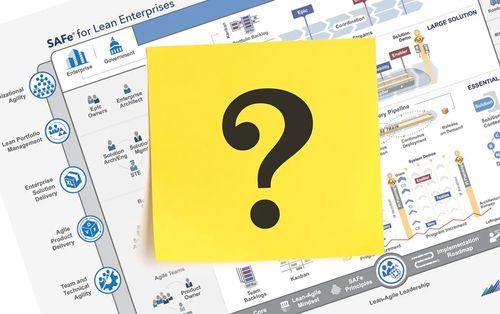
Before my first day working as an editor at Scaled Agile, I looked at the Scaled Agile Framework® (SAFe®) website to try to grasp what Agile and my new company were all about. What happened is what I like to call the Russian doll effect: As I started to read the first line of a Big Picture article, I encountered a hyperlinked term that I didn’t know and opened that article in a new browser tab. One hour later with 17 tabs open, I felt like I had a decent handle of two terms: customer and solution.
Needless to say, it was difficult to explain what Scaled Agile was to interested family, friends, and acquaintances. After working in a SAFe environment for a few months, taking a few of our courses, and talking with some knowledgeable and experienced individuals, I was better able to answer the question, “So, what does your company do?”
“Well, it’s a business training company”
Particularly kind and interested people would ask for a little more.
“We train people in a system that helps them be more productive by changing how they work and by reorganizing their business structures. I guess it’s working because companies I recognize use it and are doing well”
Of all the people I have talked to, only one person, my uncle Tom, really wanted to get into the nitty-gritty of it all. Though they truly capture the essence of what SAFe truly is, The Lean-Agile Mindset, Core Values, SAFe Principles, and the core competencies were a bit too philosophical and abstract for light dinner conversation. Instead, I decided to connect SAFe to something he already knew: a traditional way of working.
Prescriptive versus adaptive
Traditional companies typically make big, concrete, highly defined plans for the long term. Before the work starts, they already determine who will do the work, exactly what they’ll make, and what the product will do. They define when the project will be finished and how much money it’ll take to complete it. In theory, leaders plan this way because it gives them a lot of certainty in the future, a feeling like they have a crystal ball and know what will happen.
SAFe companies recognize that it isn’t possible to have absolute certainty in the future. The world will likely be very different a year or even six months from now. Maybe new technology will be developed that could save the company time and money. Maybe the products that customers want today won’t be the ones they want in the future. This is why in SAFe, leaders have a vision of where they see the company in the long term, but workers only commit to working about every three months. The fact that teams deliver value so predictably gives leaders the certainty they desire.
In traditional companies, managers, with direction from their senior leaders, tell workers what to do, how to do it, and when to finish it. Members within a single team typically have similar backgrounds, job titles, and skills. People tend to stay in their lanes and do the same type of specialized work every day relatively independently. Individual performance is reviewed annually, and workers are awarded bonuses based on those reviews.
In SAFe companies, leaders outline the goals and objectives for the business but teams identify the work they should do to help the business achieve those goals. And individual workers decide how to do that work because they’re more knowledgeable about and closer to the hands-on work. Teams are often composed of people with different skills who can create and deliver a full product or piece of value by working together. In doing so, experts can gain functional skills in other areas to best help the team in any area in some capacity when needed. Team performance is reviewed by the business about every three months based on how well they completed what they committed to. There are no individual performance bonuses because each individual’s goal is to best help the business deliver value, not to simply get better at their particular job in a vacuum.
Ultimately, SAFe applies prioritization, respect, value, predictability, quick movement, transparency, and communication to make companies, their products, and their workers’ lives better—and their customers happier.
Start where you are
Though not intended to confuse (quite the opposite!), the Scaled Agile Framework is a bit of a puzzle for newbies due to some of the unfamiliar jargon and acronyms. However, SAFe is a solvable puzzle, and it is worth solving. After being steeped in it for almost a year, I finally view the SAFe Big Picture as the tool it was designed to be—a great visual representation of this way of working. Plus, I’ve learned enough to function in this environment and to better align my work and my team’s work with SAFe.
Are there some things that are still a bit mystifying? Of course. I couldn’t tell you clearly what an architect does on a day-to-day basis or what the difference is between capabilities and enablers. We all need to start from where we stand today and keep moving forward. Take a course. Be curious. Ask questions (remember, there are no stupid questions). Seek out experts. In the meantime, I’ll do my best to help you by working with my team to make SAFe easier to learn and, therefore, easier to apply.
About Emma Ropski

Emma is a certified SAFe 5 Program Consultant and scrum master at Scaled Agile. As a lifelong learner and teacher, she loves to illustrate, clarify, and simplify helpful concepts to keep all teammates and students of SAFe engaged.
Share:
Back to: All Blog Posts
Next: Welcome to the Scaled Agile Blog